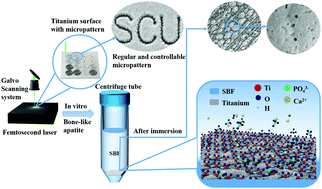Application of femtosecond laser microfabrication in the preparation of advanced bioactive titanium surfaces†
Abstract
The surface activation of titanium plays a key role in the biological properties of titanium implants as bone repair materials. Improving the ability to induce apatite precipitation on the surface was a well-accepted titanium bioactivation route. In this study, advanced femtosecond laser microfabrication was applied to modify titanium surfaces, and the effect of femtosecond laser etching on apatite precipitation was investigated and compared with popular titanium modification methods. Meanwhile, the mechanism of apatite formation after femtosecond laser modification was interpreted from the point of materials science. The surface physical–chemical characterization results showed that femtosecond laser etching can improve the surface hydrophilicity and increase the surface energy. Compared with traditional abrasive paper and acid–alkali treatment, this method increased the contents of active sites including titanium oxide and titanium-hydroxyl on titanium surfaces. TiO2 on the surface was transformed to TiO after femtosecond laser treatment. The samples etched with 0.3 W and 0.5 W femtosecond lasers had a better ability to induce apatite deposition than those treated with traditional mechanical treatment and popular acid–alkali modification, which would lead to better bioactivity and osteointegration. Considering the technical advantages of femtosecond lasers in microfabrication, it provides a more efficient and controllable scheme for the bioactivation of titanium. This research would improve the application potential of femtosecond laser treatment, such as micropattern preparation and surface activation, in the field of biomaterials.



 Please wait while we load your content...
Please wait while we load your content...